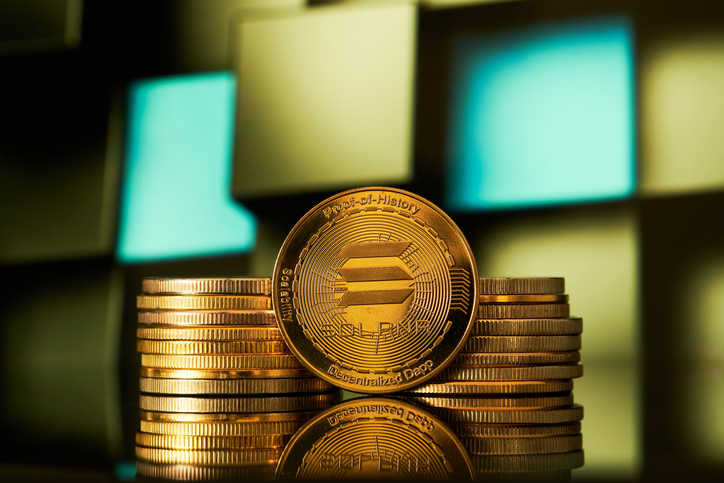- 3 Oct 2025

In the rapidly evolving world of cryptocurrencies, Solana (SOL) has emerged as one of the standout performers, capturing the attention of investors, developers, and enthusiasts alike. Over the past year, Solana’s price has seen significant growth, raising the question: Why is Solana going up? The answer lies in a combination of technological advancements, ecosystem expansion, growing adoption, and market sentiment. In this article, we’ll dive into the key factors driving Solana’s recent price surge and what it means for the future of the project.
One of the primary reasons behind Solana’s rising value is its innovative technology. Solana offers a highly scalable blockchain platform that addresses two of the biggest issues plaguing other networks—speed and cost.
Solana boasts one of the fastest blockchains in the market, with the ability to process over 65,000 transactions per second (TPS). This is far superior to Ethereum, which, during periods of high congestion, can only handle 15-30 TPS. Additionally, Solana’s transaction fees are incredibly low, making it an attractive option for developers and users who need to execute numerous transactions without worrying about exorbitant costs.
Solana’s unique Proof of History (PoH) consensus mechanism ensures that the blockchain maintains its high throughput without sacrificing decentralization or security. This technological edge has been a critical driver of investor interest, contributing to the surge in SOL’s price.
Another factor contributing to Solana’s growth is its rapidly expanding developer ecosystem. Many decentralized applications (dApps) and projects are building on Solana, from decentralized finance (DeFi) protocols to non-fungible tokens (NFTs) and gaming platforms.
The DeFi space has exploded on Solana, offering alternatives to Ethereum-based protocols, but with lower fees and faster transaction speeds. Projects like Serum (a decentralized exchange) and Raydium (an automated market maker) have gained traction within the Solana ecosystem, bringing more liquidity and utility to the blockchain.
Moreover, the NFT sector has also seen significant activity on Solana, with marketplaces like Magic Eden allowing creators to mint and trade NFTs with minimal fees. As more dApps and platforms are built on Solana, the demand for SOL, the network’s native token, continues to increase, contributing to its price surge.
Solana’s rise has also been fueled by strategic partnerships and large-scale investments from major players in the crypto and tech space. These partnerships have not only brought more visibility to Solana but have also strengthened its infrastructure and user base.
One of the most notable partnerships is with FTX, a leading cryptocurrency exchange. FTX’s decentralized exchange, Serum, is built on the Solana blockchain, and this collaboration has helped cement Solana’s reputation as a leading platform for DeFi applications.
Additionally, Solana has attracted attention from prominent venture capital firms like Andreessen Horowitz (a16z) and Alameda Research, which have invested heavily in Solana-based projects. Such backing provides confidence to retail and institutional investors, driving up demand for SOL tokens.
Market sentiment plays a crucial role in any asset’s price movement, and Solana is no exception. Several factors have contributed to the growing confidence in SOL as an investment.
In the broader cryptocurrency market, there has been a shift towards platforms that can scale effectively without high fees—an area where Solana excels. As Ethereum continues to grapple with congestion and high gas fees, investors are looking for alternatives, and Solana is often seen as a viable option.
Furthermore, Solana has benefitted from its ability to withstand broader market volatility better than some other altcoins. As a result, many investors view Solana as a more stable investment, which has helped maintain upward momentum in its price.
Institutional interest in cryptocurrencies is a significant driver of price increases, and Solana is beginning to capture the attention of large investors.
Over the past year, more institutional investors have begun allocating capital to Solana. This is due in part to the blockchain’s potential to disrupt existing systems and provide a high-speed, cost-effective alternative for decentralized applications. Additionally, Solana’s integrations with major DeFi and crypto platforms have increased its appeal to institutional investors.
As more institutions invest in Solana, it creates a cycle of positive price action, attracting even more retail and institutional investors, further driving SOL’s price upwards.
A strong, engaged community is vital for the success of any blockchain project, and Solana has fostered a dedicated community of developers, enthusiasts, and investors.
Solana Foundation has launched multiple grant programs aimed at incentivizing developers to build on the network. These grants have attracted developers who want to build innovative applications on a blockchain that can handle massive transaction volumes at low costs. As a result, more dApps are being created on Solana, further boosting the utility and demand for SOL.
The Solana community is highly active, participating in hackathons, events, and discussions that contribute to the ecosystem’s growth. This sense of community and active participation helps keep the project in the spotlight, driving more attention to SOL.
The price surge of Solana can be attributed to a combination of its cutting-edge technology, robust developer ecosystem, strategic partnerships, and positive market sentiment. Solana’s high throughput, low fees, and growing adoption across DeFi, NFTs, and other sectors make it a standout blockchain that has captured the attention of both retail and institutional investors.
As Solana continues to scale and attract more projects, the demand for SOL tokens is likely to grow, which could continue to drive its price upward. However, as with any investment, it’s essential to conduct thorough research and understand the risks involved. Nonetheless, Solana’s upward trajectory reflects its potential as one of the leading platforms in the blockchain space.